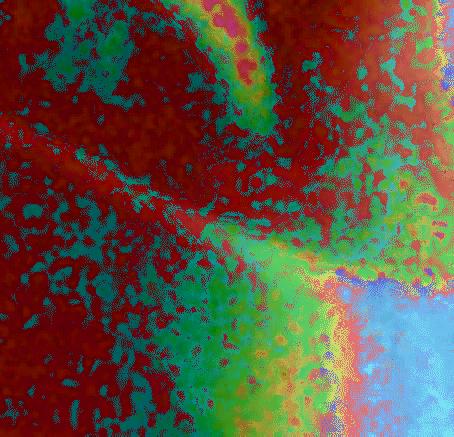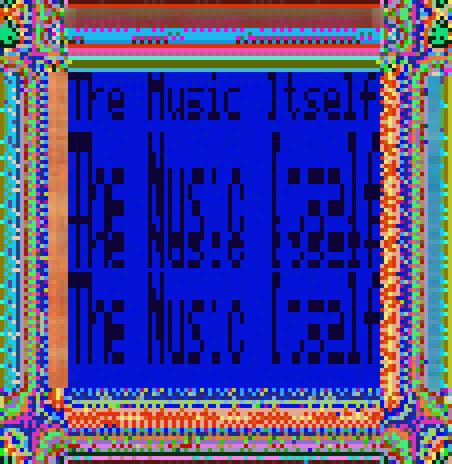
|
Wise King Taken by the Foolish One
essay no. 26
The Music Itself
Dan Plonsey
December, 2001
Keywords: music for large ensemble of unspecified instrumentation
Go to:
Wise King essays, home page,
or one of the Wise King essays: 1,
2,
3,
4,
5,
6,
7,
8,
9,
10,
11,
12,
13,
14,
15,
16,
17,
18,
19,
20,
21,
22,
23,
24,
25,
26,
or
Plonsey's "Kingdoms Diptych" home page, or
Dan Plonsey home page.
|
The Music Itself
The music was written as follows:
First, I wrote
a melody of 2938 bars (all 4/4, with constant pulse of 100 BPM), over the course of
some weeks; working for perhaps 5 to 120 minutes per day, most days. Nothing was edited out or added in
later, except for a couple places where the wrong number of beats were given to a bar.
Next, I divided the piece into 15 sections. During the course of the following
stages, I sub-divided some sections into as many as four sub-sections. Ultimately, I accorded each
sub-section status as a full section, and found that I had a total of 26 sections.
I copied the melody to disk as 26 files, using the language employed by
PMX,
by Don Simons, which is a preprocessor to MusiXTeX.
As an example of this format: Section D, PMX source,
Section D as music (PDF format, following processing by
PMX, MusiXTeX, TeX, DVIPS, ps2pdf).
Next, I devised several methods (in the form of Fortran 77 programs)
for adding bass and harmony lines to compliment, thicken,
ornament, and occur at the same time as the melody. Several of these had previously been
employed in the writing of the companion piece,
Moving About, Humming, Still Our Flowers are Blooming,
Under the Old Portcullis. These methods are as follows:
- addbassharm:
Used to add one or more bass and harmony parts (we don't distinguish between
"bass" parts and "harmony" anymore, though in earlier versions of the program
I made some forgotten distinction). In addition to the melody file, e.g., D.pmx,
there are a misleadingly named D.bass and a D.harm. The .bass file consists
of one or more rhythmic templates, each one one or more bars long. Each template is
an rhythmic pattern into which pitches will be plugged from the .harm file.
The .harm file lists the one or more acceptable harmony notes for each bar of melody.
If the melody is longer than the .harm file, then the harmony starts again from the beginning.
This whole method is related to that of writing isorhythmic motets, in which cycles of durations and
pitches repeat independently. Here, instead of fixed pitches, there are sets of acceptable pitches.
Furthermore, for each part (i.e., voice), there is a subset of acceptable pitches from which
to draw. Once the .bass and .harm files are assembled, I run addbassharm and
it alternates among the several rhythmic templates given in the .bass file. The number of
repetitions of each is a random number multiplied by a constant, supplied by the user.
- addarpeggio
Used to add one additional part. As above, a rhythmic template is supplied, but is limited to
a single template for the entire section, and only one bar long. The pitches are chosen by
making a set of acceptable pitches for each bar which consists of every pitch played by the
other parts (voices) in that same bar. An additional wrinkle is that if a pitch is repeated
immediately, it appears up or down one octave.
- addparallelharms
Used to add one or more parts to the original melody. A .harm file is constructed, of
a different format than for addbassharm: the leftmost column consists of one
row each for each of the pitches used in the original melody. Then there is one
column for each of the added parts (voices). addparallelharms copies the exact rhythm
of the melody, substituting for each part (voice) the pitch from the row corresponding to
the pitch in the melody. That is, the result is a piece in rhythmic unison, with each note
in the melody being harmonized identically on every appearance.
- addcanon
Used to add one or more parts in canon with the melody, entrances separated by one bar.
- addresponse
Used to divide a melody among two voices. Switches from one voice to the other at every breath mark.
Using these tools and other methods described below, I fleshed the melody out into a
2 to 8 voice score for each section. The number of parts and the methods used to generate
them were chosen intuitively, with an eye for variety and lack of regimented pattern.
At the end of notes for each page I give the clef names for the parts. E.g., TTTBB
means five parts of which first 3 are treble clef, last two are bass clef!
- A:
Oompah-esque use of addbassharm. Independent
addbassharm tuba part is is from 4 and 5 bar phrases.
TTBBB
- B:
Used addparallelharms. TTBB
- C:
addbassharm for four accompanying parts, using a 10-bar harmonic cycle
(which was used to compose the melody for this section). Then added
independent addbassharm part
(with same .bass file as part A) for tuba. We
called this section the "Henry Threadgill section."
TTTBBB.
- D:
4-part canon (one bar apart), plus quarter-note addarpeggio part.
- E:
Oompah-esque use of addbassharm, plus particularly thorny
addarpeggio part. TBTTB.
- F:
Voices 0 and 1 split the melody (addresponse).
Other parts accompany rather freely.
- G:
Oompah-esque use of addbassharm,
voice 2 generated by addarpeggio.
TTTTB
- H:
addparallelharms. TTB.
- I:
Chords chosen, counterpoint was written freely. TTTB.
- J:
Ostinati which change periodically, UN-mechanically added. TTB
- K:
Fixed ostinati, plus a difficult addarpeggio part.
TTTB.
- L:
Near-unison rhythm.
TB.
- M:
Oompah-esque use of addbassharm. TTTTBB.
- N:
Parts 0 and 2 divide the melody (addresponse), part 1 generated
from addarpeggio.
TTT
- O:
Parts 0 and 1 divide the melody, then melody is given to part 2. Part 3 is an ostinato.
TTBB.
- P:
Quarter-note harmonies, freely applied.
TTB
- Q:
Melody in part 0 is doubled by 5 other parts which divide melody like a bell choir.
Also two parts generated through oompah-esque use of addbassharm.
TTTTTBBB
- R:
Each part harmonizes freely with the one before it (I call this
"blind sequential harmonization"). TTTTBB.
- S:
Unison rhythm from addparallelharms, part 1 generated by addarpeggio.
TTTTB.
- T:
Another use of "blind sequential harmonization." TTB.
- U:
Ostinati which change periodically, UN-mechanically added. TTTB.
- V:
Part 1 generated by addarpeggio. Part 2 is same as part 0, but down a sixth.
TBT.
- W:
Melody, bass and keyboard. TB.
- X:
Unison rhythm, addparallelharms, with fairly dissonant harmonies. TTTB.
- Y:
Parts 1 and 2 are drones, part 3 is from addparallelharms.
TTTB.
- Z:
Uses addparallelharms to construct all major chords.
TTB.
-- Dan Plonsey, February, 2002,
El Cerrito, California
Go to:
Wise King essays: 1,
2,
3,
4,
5,
6,
7,
8,
9,
10,
11,
12,
13,
14,
15,
16,
17,
18,
19,
20,
21,
22,
23,
24,
25,
26,
or
Plonsey's "Kingdoms Diptych" home page, or
Dan Plonsey home page.
|

|

